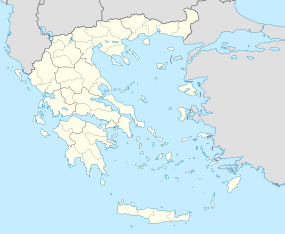Heraion of Perachora
| Ηραίο Περαχώρας (in Greek) | |

Overview of the lower sanctuary looking west with the L-shaped stoa in foreground and the temple of Hera Akraia?
|
|
| Location | Limni Vouliagmenis, Corinthia, Greece |
|---|---|
| Region | Corinthia |
| Coordinates | 38°01′41″N 22°51′09″E / 38.02806°N 22.85250°ECoordinates: 38°01′41″N 22°51′09″E / 38.02806°N 22.85250°E |
| Type | Sanctuary |
| History | |
| Periods | Greek Dark Ages to Hellenistic |
| Satellite of | Corinth |
The Heraion of Perachora (Greek: Ηραίο Περαχώρας) was a sanctuary of the goddess Hera situated in a small cove of the Corinthian gulf at the end of the Perachora peninsula. In addition to a temple of Hera of unusual construction and antiquity, the remains of a number of other structures have also been found, including a L-shaped stoa, a large cistern, dining rooms, and a second potential temple. The Sanctuary of Hera at Perachora is 14.2 kilometres (8.8 mi) north-northwest of Corinth and 75.9 kilometres (47.2 mi) west of Athens. Although there is debate between Argos, Megara and Corinth, the sanctuary was probably under the control of Corinth, as it faced the harbors of that powerful city across the Corinthian gulf. Cult activity at the site continued from perhaps the 9th century BCE to 146 BCE, when the Roman general Mummius sacked Corinth during the war with the Achaean League. In the Roman period, domestic structures were built on the site, indicating that the area was no longer a sanctuary. This site is significant for the study of the origins of Greek temple architecture and rural cults.
There is a legend recounted in Euripides that Medea buried her murdered children at a sanctuary of Hera Akraia as she fled from Corinth. This may be a reference to this site. Herodotus tells the story of Periander stripping the clothes off of the Corinthian women at a sanctuary of Hera. In the 1st century CE, the Greek historian Strabo wrote that there was an oracle associated with the sanctuary.
The known structures of the sanctuary cover a rectangle approximately 45 metres (148 ft) north–south and 245 metres (804 ft) east–west. The sanctuary wrapped around a small cove and extended toward the east uphill along a ridge. The structures will be discussed in order from west to east.
At the extreme southwest end of the sanctuary, there is a polygonal area of roughly 25 by 25 metres (82 by 82 ft) largely cut into the rock beside the cove. This structure has been variously termed the agora, or the west court. This structure may date to the 6th century BCE and thus be contemporary with the Temple of Hera Akraia. It appears to have been destroyed in the 4th century BCE; it has been proposed that the L-shaped stoa took over its function. There appear to have been colonnades on the western and southern sides. There are remains of a house from the Roman period roughly at the center of the area.
...
Wikipedia

